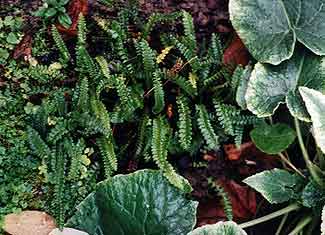 The Alpine Water Fern
The Alpine Water Fern
"Beyond brick wall I seem to see
Fern dells & rocky rills . . .
O crazy dream! O God, to be
A shephard of the hills!"
-Robert William Service
(1874-1958)
(1874-1958)
The Blechnum family of "water ferns" are not called that for living in water; they are fully terrestrial, though often preferring creek edges so have come as a group to be associated with nearby waterways. Still, as with most ferns, although at risk in drought conditions, it is equally at risk if swamped in poorly draining soil. They are hardiest in damp acidic ground, liking moisture-holding peat or sphagnum about them. They tend to prefer to have many of their rhizomes right at the surface & can be hard to establish at first especially if you place their roots deeply when first transplanted.
The Alpine Water Fern (Blechnum penna-marina alpina), also called Little Hard Fern, is the smalleset of the water ferns, & one of the spiffiest of evergreen varieties. B. penna-marina has an extensive "circum-antarctic" southern hemisphere distribution inclusive of Australia, Tasmania, New Zealand, lower Pacific islands, & South America. It is found at elevations up to or exceeding 3,000 feet, but adapts readily to sea-level gardens. The specific subspecies alpina entered into cultivation from New Zealand.
This naturally dwarf species eventually began spreading pretty rapidly for us, though it was slow at first. It is divisible in spring, & we've already divided it once, so we now have it growing in two shady locations. This portrait is from the shade corridor beyond the arbor shown on the "flagstone path" page. It doesn't seem to mind getting additional shade form the variegated money-plant above.
It eventually spreads into quite a marvelous creeping groundcover. Their tough little leaves are more tolerant of low humidity than are most ferns, so they adapt pretty nicely as indoor plants too, & make a stunning landscape addition under bonsai trees.
The majority of the wee fronds are sterile, spreading only by their rhizomes, & these alone are evergreen. It also produces distinct upright fronds that produce spoors & later die; the spoors are easily propagated. Generally a dark green as in this January portrait, new spring growth can be bronzy.